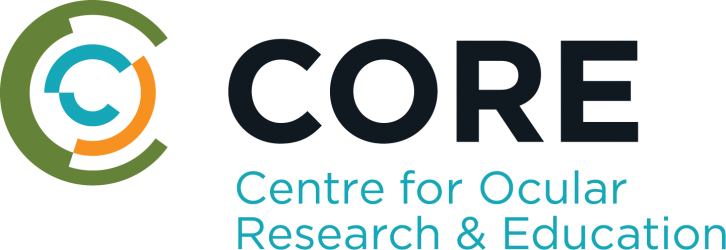Peer-reviewed Articles
Please use the year list below to look at past peer-reviewed articles.
2025
Downie,L.E., Craig,J.P., Stapleton,F., Tan,J., Jones,L., Ng, A.Y., Hinds,M., Bosworth,C., Alster,Y.
Efficacy and safety of AZR-MD-001 selenium sulfide ophthalmic ointment in adults with meibomian gland dysfunction over six months of treatment: A Phase 2, vehicle-controlled, randomized extension trial
Ocular Surface 2025;35(January):15-24 [ Show Abstract ]
Purpose: To determine the efficacy and safety of AZR-MD-001 (0.5 % and 1.0 %) ophthalmic ointment, relative to vehicle, over 3–6 months of treatment, in participants with meibomian gland dysfunction (MGD).
Methods: This was a Phase 2, randomized, vehicle-controlled, multicenter extension clinical trial. Eligible participants were adults with MGD (meibomian gland secretion score (MGS) ≤12 out of 15 glands) who discontinued all other dry eye or MGD treatments. Participants were randomized 1:1:1 to apply AZR-MD-001 1.0 %, 0.5 %, or vehicle to the lower eyelids, twice weekly. Key exploratory endpoints included the least-squared mean difference between groups in the change from baseline in clinical signs (meibomian gland yielding score; MGYLS) and symptoms (Ocular Surface Disease Index; OSDI), at clinic visits at Month 4.5 and 6, and safety measures from 36 months.
Results: Participants (66.5 % female) were randomized, at baseline, to AZR-MD-001 0.5 % (n = 82), 1.0 % (n = 83), or vehicle (n = 80). Statistically significant improvements, compared to vehicle, were observed at Month 6 in MGYLS for both AZR-MD-001 groups (0.5 % group: 1.9, 95 % CI 0.9 to 2.8, P = 0.002; 1.0 % group: 1.1, 95 % CI 0.2 to 2.1, P = 0.026), and in OSDI score for the 0.5 % group (−4.5, 95 % CI -8.0 to −0.9, P = 0.0135). The most common adverse events for AZR-MD-001 were application site pain, superficial punctate keratitis and eye pain; most were mild to moderate in severity, and decreased in incidence over time.
Conclusions: AZR-MD-001 (0.5 %) was efficacious in treating signs and symptoms of MGD over six months, with a lower observed incidence of new adverse events over time.
Efron,N., Morgan,P., Woods,C. A., Jones,D. A., Jones,L., Santodomingo-Rubido,J., Nichols,J.
International trends in prescribing contact lenses for myopia control (2011–2024): An update
Contact Lens Anterior Eye 2025;Online ahead of print [ Show Abstract ]
Purpose: The progression of myopia can be slowed using soft myopia control (SMC) and orthokeratology myopia control (OKMC) contact lenses. The purpose of this work is to update an earlier survey (covering years 2011–2018) by describing international trends in SMC and OKMC fitting between 2011 and 2024.
Method: An annual contact lens prescribing survey was sent to eye care practitioners in up to 71 countries between 2011 and 2024. Data are reported here for 8,578 lens fits undertaken across 20 countries to 6–12-year-old children, comprising 688 SMC fits, 918 OKMC fits, and 6,972 non-myopia control (NMC) fits. To assess current trends, the proportion of fits between 2020 and 2024 for 12 countries returning ≥30 myopia control fits was analysed (n = 2,277 fits).
Results: There was a small increase in SMC fitting from 0.0 % in 2011 to 3.9 % in 2016, a significant increase to 29.5 % in 2021, and a slower increase to 30.4 % in 2024 (p < 0.0001). The proportion of OKMC fits, in relation to all rigid lens fits, increased from 40.8 % in 2011 to 86.9 % in 2024 (p < 0.0001). Of all soft lens fits, SMC fits were 7.2 % and 8.7 % to males and females, respectively (p = 0.0008). There was a decrease in the percentage of SMC fits with increasing age (p < 0.0001). No such sex/age associations were evident with OKMC fits. The proportion of all contact lens fits over the past 5 years (2020–2024) were as follows: SMC fits – 24 % (n = 525), OKMC fits – 17 % (n = 320), and NMC lens fits – 59 % (n = 1,332).
Conclusion: There has been a substantial increase in SMC and OKMC lens fitting over the past 14 years, reflecting a heightened awareness among eye care practitioners and parents of the importance of slowing the progression of myopia in children.
Flitcroft,I., Bullimore,M.A., Gifford,K., Jonas,J. B., Jones,D., Jones,L., Kang,P., Resnikocc,S., Walline,J., Wildsoet,C.
Myopia Correction, Myopia Control and Myopia Management: Definitions and Recommended Usage
Investigative Ophthalmology & Visual Science 2025;Online ahead of print [ Show Abstract ]
The terms “myopia management” and “myopia control” are frequently used in both eye care and research settings, sometimes interchangeably, leading to potential confusion. Although both terms are important and useful in different situations, they represent fundamentally distinct concepts. When using such terms, it is important to consider the context and application—for example, whether they are being discussed with parents or included in written materials such as medical publications, marketing content, or regulatory documents. Their use may also vary by country. The aim of this article is to provide clear definitions of these terms, based on their evolution in recent years,1–4 and informed by consultations with industry representatives and members of the myopia research community.
Garg,P., Shokrollahi,P., Darge,H., Phan,C-M., Jones,L.
Controlled PVA Release from Chemical-Physical Interpenetrating Networks to Treat Dry Eyes
ACS Omega 2025;10(1):1249-1260 [ Show Abstract ]
Dry eye disease is becoming increasingly prevalent, and lubricating eye drops, a mainstay of its treatment, have a short duration of time on the ocular surface. Although there are various drug delivery methods to increase the ocular surface residence time of a topical lubricant, the main problem is the burst release from these delivery systems. To overcome this limitation, herein, a chemical–physical interpenetrating network (IPN) was fabricated to take control over the release of poly(vinyl alcohol) (PVA), a well-known therapeutic agent used to stabilize tear film, from gelatin methacrylate (GelMA) hydrogels. In this report, PVA was specifically used as part of a GelMA-based polymeric hydrogel owing to its physical cross-linking ability via a simple freeze-thaw method. The interpenetrating polymer network was fabricated in a sequential manner where GelMA was chemically cross-linked by photo-cross-linking, followed by physical cross-linking of PVA using a relatively short freeze-thaw cycle. Interestingly, upon applying only one short freeze-thaw cycle (of 1 or 2 h), the crystalline domains in PVA were increased in the interpenetrating network. The endothermic peaks at 48 and 60 °C in differential scanning calorimetry (DSC) thermograms and 20°–2θ peaks in X-ray diffraction (XRD) patterns suggest the presence of these crystalline domains. With the help of a suite of characterization, we further delineate the role of freeze-thaw cycles in taking control over the release of PVA. The release profiles of the PVA-containing hydrogels showed highest linearity with the Korsmeyer–Peppas model (0.9944 < R2 < 0.9952), indicating that these systems follow non-Fickian or anomalous transport.
Garg,P., Shokrollahi,P., Darge,H., Phan,C-M., Jones,L.
3D-Printed Contact Lenses to Release Polyvinyl Alcohol as a Therapeutic Agent for the Treatment of Dry Eyes
Pharmaceutics 2025;17(2):Article 219 [ Show Abstract ]
Purpose: Dry eye disease is highly prevalent, and the most common treatment, lubricating eye drops, only remains effective for a very short period of time. This project aims to 3D print a proof-of-concept, custom-fit, polyvinyl alcohol (PVA)-eluting contact lens (CL) for the treatment of dry eye disease. PVA is a commonly used viscosity enhancer in eye drops, with the capability of reducing symptoms of dry eye by stabilizing the tear film and reducing tear evaporation. The protective effects of PVA could be attributed to its water-retaining ability, which provides moisturization and prevents the loss of water.
Method: In this work, a low-cost stereolithography-based 3D printer was retrofitted with a humidity and temperature control kit to 3D print a PVA-loaded custom-fit CL. To evaluate the print quality of the 3D-printed CL, circularity was used to evaluate the shape fidelity in 3D printing. The PVA release from these lenses was assessed, along with its role in acting as a viscosity enhancer. The effect of PVA was further analyzed by a dry eye disease (desiccation stress) cell model.
Results: The shape fidelity evaluation of the 3D-printed CL displayed excellent circularity. The diameter, sagittal depth, and base curve of the 3D-printed lenses were measured to be 14.27 ± 0.06 mm, 3.77 ± 0.16 mm, and 6.4 ± 0.24 mm, respectively. The PVA release curves showed that approximately 1300 µg of PVA was released over the study duration of 24 h.
Conclusions: Overall, this work demonstrates that a 3D-printed PVA-eluting CL is a promising candidate for the treatment of dry eye.
Garg,P., Shokrollahi,P., Phan,C.-M., Jones,L.
Biodegradable 3D-Printed Conjunctival Inserts for the Treatment of Dry Eyes
Polymers 2025;17(5): [ Show Abstract ]
Purpose: To fabricate 3D-printed, biodegradable conjunctival gelatin methacrylate (GelMA) inserts that can release polyvinyl alcohol (PVA) when exposed to an ocular surface enzyme.
Method: In this work, biodegradable conjunctival inserts were 3D-printed using a stereolithography-based technique. The release of PVA from these insert formulations (containing 10% GelMA and 5% PVA (P-Gel-5%)) was assessed along with different mathematical models of drug release. The biodegradation rates of these inserts were studied in the presence of a tear-film enzyme (matrix metalloproteinase-9; MMP9). The morphology of the inserts before and after enzymatic degradation was monitored using scanning electron microscopy.
Results: The 3D-printed P-Gel-5% inserts formed a semi-interpenetrating network, which was mechanically stronger than GelMA inserts. The PVA release graphs demonstrate that at the end of 24 h, 222.7 ± 20.3 µg, 265.5 ± 27.1 µg, and 242.7 ± 30.4 µg of PVA were released when exposed to 25, 50, and 100 µg/mL of MMP9, respectively. The release profiles of the P-Gel-5% containing hydrogels in the presence of different concentrations of MMP9 showed the highest linearity with the Korsmeyer–Peppas model. The results suggest that the degradation rate over 24 h is a function of MMP9 enzyme concentration. Over 80% of P-Gel-5% inserts were degraded at the end of 8 h, 12 h, and 24 h in the presence of 100, 50, and 25 µg/mL MMP9 enzyme solutions, respectively.
Conclusions: These results demonstrate the potential for 3D printing of GelMA for use as conjunctival inserts. These inserts could be used to deliver PVA, which is a well-known therapeutic agent for dry eye disease. PVA release is influenced by multiple mechanisms, including diffusion and enzymatic degradation, which is supported by morphological studies and biodegradation results.
Jiang,Q., Zhang,Z., Niu,L., Wang,B., Fadel,D., Wei,R., Chen,Z.
Changes in anterior segment after short-term scleral lens wear in healthy Chinese population
Contact Lens Anterior Eye 2025;48(1):102291 [ Show Abstract ]
Purpose
To evaluate the impact of short-term scleral lens (SL) wear on anterior chamber (AC) dimension and central corneal thickness (CCT) in healthy Chinese people.
Methods
This is a prospective, daily wear study. Eligible participants were dispensed SLs to correct refractive errors. Anterior segment (AS) parameters were measured by AS optical coherence tomography (AS-OCT) before, during, and after 2 and 4 hours of lens wear. Repeated-measures analysis of variance (ANOVA) was used to analyze the changes in AS parameters over time.
Results
Twelve subjects (10 females and 2 males) with a mean age of 25.3 ± 3.8 years (ranging from 21 to 34 years) were recruited. The AC parameters, including anterior chamber depth (ACD) from the endothelium (endo-ACD), angle opening distance at 500 μm (AOD500), and trabecular-iris space area at 500 μm (TISA500), significantly decreased after wearing SLs for 4 hours (P<0.05). CCT increased by 12 μm (2.29 %) after wearing SLs for 4 hours (P=0.013).
Conclusion
This study suggests that SL wear has a significant impact on AS dimensions in patients with healthy corneas in the short term with SL in situ, but tend to recover quickly after SL removal. Further research is needed to determine whether the change in AS dimensions during SL wear affects aqueous humor (AH) outflow and causes changes in intraocular pressure (IOP).
Jones L, Koetting C.
Dry eye pharmacological treatment update
2025
Jones, L., Craig, J. P., Markoulli, M., Karpecki, P,. Akpek, E. K., Basu, S., Bitton, E., Chen, W., Dhaliwal, D. K., Dogru, M., Gomes, J. A. P., Koehler, M., Mehta, J. S., Perez, V. L., Stapleton, F., Sullivan, D. A., Tauber, J., Tong, L.,Travé-Huarte, S., Wolffsohn, J. S., Alves, M., Baudouin, C., Downie, L., Giannaccare, G., Horwath-Winter, J., Liu, Z., Koh, S., Messmer,E., Otero, E., Villani, E., Watson, S., Yoon, K. C.
TFOS DEWS III Management and Therapy Report
American Journal of Ophthalmology 2025;Online ahead of print [ Show Abstract ]
This report provides an evidence-based review of current strategies to manage dry eye disease (DED). First-line management focuses on methods to replenish, conserve and stimulate the tear film, with an emphasis on ocular supplements, which remain the cornerstone of DED treatment. Meibomian gland dysfunction, a primary contributor to DED, is typically treated with warm compresses and a wide variety of in-office treatments, including device-driven technologies to warm the eyelids, intense pulsed light therapy, low-level light therapy and other new and emerging technologies. Lid hygiene treatments include lid wipes, anti-Demodex therapies, blepharoexfoliation and topical antibiotics.
DED caused by certain etiological drivers can benefit from anti-inflammatory therapies, including corticosteroids, T-cell immunomodulatory topical drugs and a wide variety of pharmacological agents, in addition to biologic tear substitutes such as autologous serum and platelet-rich plasma. Emerging therapies, such as neuromodulation via nasal neurostimulation and novel pharmacological treatments offer potential future options. Advanced options, including amniotic membrane grafts and complex surgical methods, provide options for severe or refractory cases. Lifestyle modifications, including optimized blinking, dietary supplementation and environmental adjustments, play a crucial role in long-term management. Patient education and adherence to treatment regimens remain essential for sustained symptom relief.
The TFOS DEWS III prescribing algorithm provides an evidence-based framework to offer guidance to clinicians in selecting relevant interventions based on disease etiology that aim to provide targeted management of the subtype of DED that an individual is experiencing.
Kapadia,W., Nikhil,V., Ning,Q., Pei,Z., Phan,C.-M., Haines,L., Jones,L., Ren,C.
A novel microfluidic viscometer for measuring viscosity of ultrasmall volumes of Newtonian and non-Newtonian liquids
Journal of Micromechanics and Microengineering 2025;35(5):Article number 055005 [ Show Abstract ]
Viscosity is a critical fluid property that significantly influences fluid behavior and performance across various systems. Most commercial viscometers require relatively large sample volumes (on the order of milliliters), which restricts their utility in scenarios where only limited sample volumes are available. For instance, human tear fluid—essential for developing effective treatment strategies—is scarce (typically on microliters), especially in individuals with dry eye disease. To address this limitation, we present a novel microfluidic viscometer platform capable of measuring the viscosity of ultra-small volumes (i.e. ∼10 μl) of Newtonian and non-Newtonian fluids. The working principle is based on the Hagen-Poiseuille equation, incorporating the Weissenberg-Rabinowitsch-Mooney correction for slit-flow, and employs an optically transparent microfluidic chip integrated with supporting devices including a syringe pump, manifold, camera, and differential pressure transducer. Preliminary validation was conducted using glycerol solutions, artificial tears, and tear samples from dry and healthy eyes. This microfluidic viscometer holds promise for measuring the shear viscosity of small volumes of biofluid samples (e.g. synovial fluid, cerebrospinal fluid, tear films) or pharmaceuticals (e.g. monoclonal antibodies, ophthalmic drug delivery products) by developing surface coating materials appropriate for specific samples.
Lourenco Nogueira,C., Boegel,S.J., Shukla,M., Ngo,W., Hui,A., Jones,L., Aucoin,M.
Antiviral activity of contact lens care solutions and rub-and-rinse regimen against adenovirus
Optometry and Vision Science 2025;102(3):156-166 [ Show Abstract ]
SIGNIFICANCE
Although human adenoviruses are the leading cause of acute viral conjunctivitis, there is a lack of data surrounding the efficacy of contact lens care products against these viruses.
PURPOSE
This study investigates the antiviral activity of several commercially available contact lens care solutions against human adenovirus type 5 (Ad5).
METHODS
Six contact lens care solutions (Biotrue, Boston Simplus, OPTI-FREE Puremoist, Clear Care, cleadew, and cleadew GP) were investigated. Quantitative suspensions tests were conducted on Ad5 solutions after interaction with the different contact lens care solutions for 4 or 6 hours. For the hydrogen peroxide solution (Clear Care), interaction times of 0, 2, 4, and 6 hours prior to neutralization were also investigated. Finally, the impact of rubbing and rinsing of Ad5 contaminated contact lenses with the solutions was studied.
RESULTS
Solutions based on povidone-iodine demonstrated a more than 3-log reduction in virus after 4 and 6 hours of incubation. In contrast, hydrogen peroxide only demonstrated a 0.52-log reduction after 6 hours of incubation. Increasing the contact time with hydrogen peroxide increased Ad5 inactivation, with a 2.18-log reduction after 6 hours of incubation with the solution prior to neutralization. Nonoxidative systems did not demonstrate a significant log reduction after 4 hours of incubation. However, rubbing and rinsing of contact lenses using the nonoxidative systems reduced the virus counts from contaminated contact lenses to below the limit of quantification.
CONCLUSIONS
Povidone-iodine solutions have a significant effect on reducing the viability of Ad5. Hydrogen peroxide care solutions are effective only if unneutralized contact time is increased. Nonoxidative systems can be effective in combating contaminated lenses only with the addition of a rub-and-rinse step.
Ngo,W., Nagaarudkumaran,N., Huynh,C. B.
Refrigeration reduces instillation discomfort of a 0.09% cyclosporine A solution
Optometry and Vision Science 2025;102(1):14-19 [ Show Abstract ]
Significance: Topical cyclosporine A (CsA) for the treatment of dry eye disease is often associated with instillation discomfort, which may negatively influence patient adherence to therapy. This study found that refrigerating topical CsA reduced instillation discomfort compared with instillation of warm CsA. Thus, refrigerating CsA prior to instillation may improve patient experience when using CsA to manage dry eye disease.
Purpose: This study aimed to quantify instillation discomfort associated with cold or warm instillation of a 0.09% CsA.
Methods: Forty participants with symptomatic aqueous deficient dry eye were enrolled. A drop of cold (4°C) CsA was instilled in one eye, and a drop of warm (23°C) CsA was instilled in the other eye. The order and eye receiving the cold drop were randomized. Participants rated the discomfort of each eye (0, no discomfort; 10, maximal discomfort) prior to drop instillation, immediately post-instillation, and at each subsequent minute for 10 minutes. Area under the curve was used to quantify cumulative discomfort.
Results: Forty participants (39.6 ± 18.9 years old, 82% female) completed the study. A majority of participants (n = 24, 60%) experienced reduced cumulative discomfort with cold CsA, whereas the remainder experienced minimal difference (n = 10, 25%) or increased cumulative discomfort (n = 6, 15%). For those with reduced discomfort (n = 24), cumulative discomfort associated with cold instillation (median, 11.5 [2.2, 20.0]) was significantly lower (p<0.01) than cumulative discomfort associated with warm instillation (median, 17.5 [11.2, 32.2]). Cold instillation was associated with a median reduction of 1 discomfort point immediately post-instillation and at all subsequent time points (all p≤0.04, but not significant at t = 10), compared with warm instillation.
Conclusions: Up to 60% of participants found that cold instillation of CsA solution induced less discomfort than warm instillation, lasting up to 9 minutes post-instillation. In contrast, although 15% of participants found reduced discomfort with warm instillation, the magnitude of discomfort associated with warm instillation was not significantly different than cold instillation.
Perez, V. L., Chen, W., Craig, J. P., Dogru, M., Jones, L., Stapleton, F., Wolffsohn, J. S., Sullivan, D. A.
TFOS DEWS III Editorial
American Journal of Ophthalmology 2025;Online ahead of print [ Show Abstract ]
The Tear Film & Ocular Surface Society (TFOS), a non-profit organization, was created to advance the research, literacy, and educational aspects of the scientific field of the tear film and ocular surface. Since its incorporation in 2000, TFOS has launched numerous global initiatives. Perhaps the best-known are the TFOS Workshops, especially those related to dry eye disease (DED). DED afflicts hundreds of millions of people worldwide, is a leading cause of patient visits to eye care practitioners, and, if moderate or severe, is associated with significant pain, role limitations, low vitality and poor general health.
Phan,C-M., Hui,A., Shi,X., Zheng,Y., Subbaraman,L., Wu,J., Jones,L.
The Impact of Comfort Eluting Agents and Replacement Frequency on Enhancing Contact Lens Performance
Clinical Ophthalmology 2025;19(March 12):857-873 [ Show Abstract ]
This review explores the development and clinical implications of soft contact lenses designed to elute comfort agents, emphasizing their role in enhancing user experience and ocular health. As discomfort remains one of the primary reasons for discontinuation of lens wear, this concept aims to address this challenge by gradually releasing these agents over their period of use. This review also explores the effectiveness, safety, and user satisfaction associated with frequent replacement schedules of these lenses. Clinical trials demonstrate that lenses with eluting comfort agents significantly reduce dryness and irritation, leading to improved wear-time and overall comfort. The findings suggest that frequent replacement not only enhances lens hygiene but also maximizes the therapeutic benefits of the eluted agents, promoting a healthier ocular environment. The implications for practice highlight a shift towards more patient-centered approaches in contact lens design and management, aiming to improve adherence and satisfaction among users. This research paves the way for future innovations in contact lens technology, focusing on personalized solutions that cater to individual comfort needs.
Phan,C. M., Wulff,D., Thacker,M., Hui,A.
Drug releasing contact lenses and their application to disease presentations
Clinical and Experimental Optometry 2025;Online ahead of print [ Show Abstract ]
Eye drops, the most common method for anterior segment treatment, face challenges of inefficiency, with less than 7% instilled drugs typically reaching target tissues of interest. The advent of contact lens drug delivery systems offers a paradigm shift, enhancing drug residence time and bioavailability on the ocular surface. This review focuses on the considerations and challenges in developing contact lenses for drug delivery, particularly for managing four categories of ocular diseases: anterior segment infections, dry eye disease, ocular allergies, and glaucoma. Each disease category requires tailored therapeutic approaches, and the technical intricacies of drug-releasing contact lenses must address concerns related to lens properties, drug release duration, and safety. The aim of this review is to provide insights into the therapeutic needs of ocular diseases and offer a comprehensive overview of the progress made in this innovative approach. The emergence of a commercially available ketotifen fumarate-releasing lens serves as a testament to the feasibility and potential benefits of this innovative approach, paving the way for further refinement and targeted applications in ocular therapeutics.
Phan,C.-M., Ho,B., Hui,A., Walther,H., Zhen,Y., Subbaraman,L., Shi,X., Wu,J., Jones,L.
Evaluating the initial and end-of-day wettability of contemporary daily disposable contact lenses using various in vitro methods
Optometry and Vision Science 2025;102(5):375-381 [ Show Abstract ]
SIGNIFICANCE:
Contact lens wettability is potentially correlated with friction, which is linked to lens comfort. However, measuring wettability can be highly variable. This study assessed wettability using three techniques for a more accurate profile.
PURPOSE:
To evaluate the wettability of contemporary daily disposable contact lenses after 16 hours on an in vitro model using the sessile drop, captive bubble, and a novel in vitro noninvasive keratograph breakup time (NIKBUT) method.
METHODS:
The wettability of six contemporary silicone hydrogel contact lens materials (verofilcon A, delefilcon A, senofilcon A, kalifilcon A, stenfilcon A, and somofilcon A) and two conventional hydrogel materials (nesofilcon A and etafilcon A) were evaluated using an in vitro blink model at t = 0 and 16 hours. The blink rates of the eye model were 20 blinks per minute. Sessile drop and captive bubble angles were analyzed using the Optical Contact Analyzer. NIKBUT was assessed on a blink model in combination with the OCULUS Keratograph 5M.
RESULTS:
There were no significant differences in wettability for any lens types between 0 and 16 hours when assessed using the captive bubble or NIKBUT methods (p>0.05). For the sessile drop method, verofilcon A had the lowest contact angle values (36.5 ± 2.9°), and all lenses except for etafilcon A had similar wettability after 16 hours. All the lenses had similar wettability when assessed using the captive bubble method, suggesting that they had similar wettability under optimal wetting conditions. For NIKBUT, delefilcon A had the longest NIKBUT values (9.0 ± 1.0 s) after 16 hours.
CONCLUSIONS:
The sessile drop technique produced the most measurable differences in wettability between different lens types, whereas the captive bubble technique was not able to provide any measurable differences between lenses. NIKBUT measurements may provide a better measure of on-eye wettability, but variability in the results using the current eye model still needs to be addressed in future studies for improved repeatability. Although the contact lenses showed different contact angles and NIKBUT results, their in vitro wettability did not significantly change over the 16 hours of simulated wear in terms of the captive bubble or NIKBUT values.
Richards,J., Jaskulski,M., Woods,J., Guthrie,S., Kollbaum,P.
Optical characterisation and vision quality assessment of two myopia control contact lenses
Ophthalmic and Physiological Optics 2025;Online ahead of print [ Show Abstract ]
Purpose
This investigation examined the image and vision quality of two commercially available daily disposable myopia control soft contact lenses.
Methods
Wavefront errors were measured with an SHS Ophthalmic aberrometer for two myopia control soft contact lenses: a coaxially designed dual-focus lens (omafilcon A, CooperVision MiSight® 1 day, MS1d) and a design employing multiple add powers that included non-coaxial optics in annular add zones (senofilcon A, Johnson & Johnson Vision ACUVUE® Abiliti™ 1-Day, AB). Geometric optics ray tracing generated point-spread functions and wave optics were used to compare modulation transfer functions (MTFs) and simulated letter images. Twenty-six myopic children completed a randomised, non-dispensing, contralateral double-masked clinical trial. After 1 h of wear, right and left eye visual acuity (VA), subjective vision quality and lens preference (Likert) were assessed while viewing monocularly.
Results
The lens containing non-coaxial optics employed a small central zone with approximately +10.00 D of added power and two annular rings with a power gradient typical of non-coaxial optics. The coaxial design contained a centre zone with a distance correction and two annular zones with a fixed add power of approximately +2.00 D. MTFs and simulated images were better with small pupils, which was most noticeable with the coaxial design. Distance VA was -0.02 ± 0.04 with MS1d and 0.09 ± 0.08 with AB, p < 0.01. The majority of participants (77%) reported a preference for one lens; 54% preferred the MS1d and 23% preferred the AB lens.
Conclusions
Myopia control contact lenses employing coaxial or a mixture of coaxial and non-coaxial optics both reduced retinal image contrast but successfully imaged high spatial frequencies and provided high quality of vision. Image and vision quality were slightly superior in the lens employing coaxial optics alone.
Shokrollahi,P., Garg,P., Wulff,D., Hui,Al., Phan,C-M., Jones,L.
Vat Photopolymerization 3D Printing Optimization: Analysis of Print Conditions and Print Quality for Complex Geometries and Ocular Applications
International Journal of Pharmaceutics 2025;668(January):Article 124999 [ Show Abstract ]
Abstract: 3D printing, also known as additive manufacturing, continues to reshape manufacturing paradigms in healthcare by providing customized on-demand object fabrication. However, stereolithography-based 3D printers encounter a conflict between optimizing printing parameters, requiring more time, and print efficiency, requiring less time. Moreover, commonly used metrics to assess shape fidelity of 3D printed hydrogel materials like ‘circularity’ and ‘printability’ are limited by the soft nature of hydrogels, that can cause irregularities in their boundary. To unlock the full potential of 3D printing of biomaterials, it is also necessary to understand correlation between printing parameters and ink properties. In this work, a method based on curing depth, overcuring (cumulative cure), and print thickness was developed, which enables a time-efficient and reliable determination of printing conditions for complex geometries using gelatin methacrylate hydrogel biomaterial ink. We also examined the impact of printing direction on the print quality in terms of object/print thickness and aspect ratio. Moreover, the effects of dye concentration, exposure time, and layer thickness on print quality were evaluated, with discussions focused on the correlation between print dimension to layer thickness. Further evaluation was achieved by successfully printing bioinspired corneal stroma-like scaffold and delicate structures like a contact lens and a model eyeball, substantially expanding the scope of this method in producing high-quality prints with intricate details. We also demonstrate the effectiveness of ‘Feret ratio,’ another measure of object shape, in assessing the shape fidelity of different prints. Overall, the results highlight the practical potential of this method in enhancing the speed and reliability of the 3D printing processes involving complex geometries using a low-cost 3D printers.
Stapleton,F., Argüeso,P., Asbell,P., Azar,D., Bosworth,C., Chen,W., Ciolino,J., Craig,J., Gallar,J., Galor,A., Gomes,J. A. P., Jalbert,I., Jie,Y., Jones,L., Konomi,K., Liu,Y., Merayo-Lloves,J., Oliveira,F. R., Perez Quinones,V. A., Rocha,E. M., Sullivan,B. D., Sullivan,D. A., Vehof,J., Vitale,S., Willcox,M., Wolffsohn,J., Dogru,M.
TFOS DEWS III Digest Report
American Journal of Ophthalmology 2025;Online ahead of print [ Show Abstract ]
This digest summarises the interdisciplinary research in dry eye disease (DED) published since the 2017 TFOS DEWS II reports. It comprises seven topics including Sex, Gender, and Hormones, Epidemiology, Pathophysiology, Tear Film, Pain and Sensation, Iatrogenic and Clinical Trial Design and explores how each of these inform diagnostic methodology, disease subtype and management of DED.
Sex- and gender-related differences significantly influence the ocular surface due to hormones, sex chromosomes, sex-specific autosomal factors, epigenetics, care-seeking behaviors, and service utilization. Epidemiological data reveal that DED prevalence varies by age and sex, influenced by diagnostic criteria and the multifactorial nature of the disease. New risk factors for DED include environmental, iatrogenic, systemic diseases and lifestyle domains.
Pathophysiological distinctions between Aqueous Deficient Dry Eye (ADDE) and Evaporative Dry Eye (EDE) have been clarified. EDE is characterized by a muted inflammatory response at the ocular surface, meibomian gland dysfunction and conceivably phenotypic changes in corneal epithelial cells. There is an expanding role for metabolic, hormonal, physical, neural and cellular stresses, including hyperosmolarity, mitochondrial stress, and neurogenic inflammation.
Advancements in tear film research recommend new approaches to understanding DED pathogenesis and identifying biomarkers, such as microRNAs. Ocular pain perception is linked to structural integrity of corneal nerves, functional capacities of neurons, and activity of the central and peripheral nervous systems. Iatrogenic DED can result from medications, contact lenses, and surgical procedures. Clinical trials now emphasize aligning design and endpoints with DED subtypes and therapeutic mechanisms, with new therapeutics and trial designs under consideration.
Walsh,K., Jones,L., Morgan,P., Papas,E., Sulley,A.
Topical review: Twenty-five years of silicone hydrogel soft contact lenses
Optometry and Vision Science 2025;102(6):361-374 [ Show Abstract ]
SIGNIFICANCE:
The impact of silicone hydrogel (SiHy) contact lens materials on clinical contact lens practice and patient care over the past 25 years is reviewed, along with identifying areas for future innovation in material science and clinical practice to further improve outcomes for contact lens wearers.
A quarter of a century since the launch of SiHy contact lens materials, with many current eye care professionals having never practiced without them as an option, this literature review reflects how this significant change in soft lens material technology has impacted routine clinical contact lens practice and patient care. SiHy lenses now account for approximately 75% of all new daily wear soft lenses fitted and they are available in a wide variety of modalities, replacement frequencies, and designs, including daily disposable, torics, and multifocals. From the physical properties of SiHy materials and their adoption to their use in helping meet patient needs, conclusions can be made where historical clinical issues have been solved, and where innovation in material science and evolution in clinical practice are still required to deliver the best outcome for contact lens wearers. SiHy materials have largely eliminated hypoxia as a complication seen in contact lens clinical practice, and when used for daily wear, in particular as daily disposable lenses, they provide an exceptional option for vision correction that is minimally invasive, comfortable, and effective. This review helps with the understanding of how the eye care profession has adopted the use of these lenses over the last 25 years, and questions what comes next for these widely used family of materials and the opportunities that exist for them to continue contributing to patient satisfaction and to growing the contact lens market.
Wolffsohn, J. S., Benítez-Del-Castillo, J., Loya-Garcia, D., Inomata, T., Iyar, G., Liang, L., Pult, H., Sabater, A., Starr, C., Vehof, J., Wang, M. T. M., Chen, W., Craig, J. P., Dogru, M., Perez Quinones, V. L., Stapleton, F., Sullivan, D. A., Jones, L., Arita, R., Belmonte, C., Chalmers, R. L., Galor, A, Ghosh, A., Labetoulle, M., Nichols, K. K., Pucker, A. D., Rocha, E, M., Sullivan, B., Versura, P., Willcox, M. D. P.
TFOS DEWS III Diagnostic Methodology
American Journal of Ophthalmology 2025;Online ahead of print [ Show Abstract ]
A standard approach to the diagnosis of dry eye disease across eye care practitioners is critical to reassuring the patient, providing consistency between practitioners and informing governments as to the true prevalence and resulting healthcare needs. The Tear Film & Ocular Surface Society (TFOS) Dry Eye Workshop (DEWS) III has reviewed the evidence-base since their previous reports published in 2017 and revised the definition to “Dry eye is a multifactorial, symptomatic disease characterized by a loss of homeostasis of the tear film and/or ocular surface, in which tear film instability and hyperosmolarity, ocular surface inflammation and damage, and neurosensory abnormalities are etiological factors.” Key features from the definition include that dry eye disease is multifactorial, is a disease and not a syndrome and is always symptomatic. Differential diagnosis and ocular examination guidance is given along with the risk factors that should be discussed with the patient. The recommended screening questionnaire is the OSDI-6 with a cut-off score ≥4. A positive result together with a non-invasive breakup time 8mOsm/L) gives a diagnosis of dry eye. In addition, the ocular surface should be stained and positive symptomology together with >5 corneal fluorescein and/or >9 conjunctival lissamine green punctate spots and/or lid margin lissamine green staining of ≥2mm length & ≥25 %width also gives a diagnosis of dry eye. Subclassification was separated into tear film (lipid, aqueous and mucin/glycocalyx) and ocular surface and adnexa (anatomical misalignment, blink/lid closure, lid margin, neural dysfunction, ocular surface cell damage/disruption and primary inflammation/oxidative stress) components, with appropriate clinical tests and cut-offs provided to identify these etiological drivers in an individual, to inform appropriate management and therapy.
Zhang,H.Y., Xu,F.Y., Liu,K.K.K., Chan,Y.P., Chow,A., Jones,D., Lam,C.S.Y.
Myopia Management in Hong Kong
Journal of Clinical Medicine 2025;14(3):Article 698 [ Show Abstract ]
Objectives: We aimed to investigate how optometrists in Hong Kong are managing myopic and "pre-myopic" children.
Methods: Clinical files for children aged 6 to 10 years old who had eye examinations from 2017 to 2021 were retrospectively reviewed. Children were grouped by the initial spherical equivalent refractive error (SER) as myopes or pre-myopes. The demographic data, refractive error, and myopia management recommended by the optometrists were analyzed.
Results: A total of 1,318 children (859 myopes and 459 pre-myopes) from ten clinics in Hong Kong were included. Over 5 years, myopia management recommendations shifted significantly (p < 0.001). In 2017, only 18.4% of children were recommended to pursue myopia control (MC), increasing to 42.8% by 2021. The use of MC spectacle lenses increased from 7.3% in 2017 to 36.8% in 2021, becoming the most recommended option. Orthokeratology, MC contact lenses, and atropine remained stable at less than 5% over this period. Children recommended for MC approaches had significantly more myopia than those recommended single-vision lenses or monitoring (p < 0.05). Age of the first visit significantly correlated with SER change from the first visit to the next recommendation update for pre-myopes (r = 0.27, p = 0.013) but not for myopes.
Conclusions: From 2017 to 2021, myopia management patterns in Hong Kong shifted significantly, with more children being recommended for myopia control. MC spectacle lenses emerged as the most commonly recommended method. Younger pre-myopes at their first visit were more likely to have earlier management updates.





